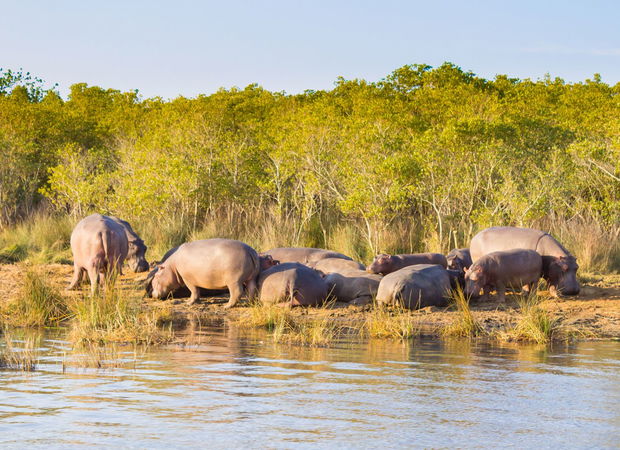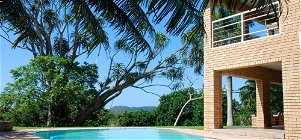Discover St Lucia, South Africa – Home of iSimangaliso Wetland Park and Unforgettable Adventures

Discover the wonders of St Lucia, South Africa—a vibrant eco-tourism haven nestled within the iconic iSimangaliso Wetland Park, a UNESCO World Heritage Site. This breathtaking destination offers a rich blend of history, wildlife, and adventure, making it perfect for nature lovers, outdoor enthusiasts, and those seeking tranquility. From thrilling safaris and hippo boat cruises to exploring dense forests and pristine beaches, St Lucia is a gateway to 21 unique ecosystems teeming with life. Stay at Ingwenya Lodge, your ideal base to experience the magic of this unspoiled paradise. Book now to begin your unforgettable journey!
About St. Lucia: Your Gateway to iSimangaliso Wetland Park
Life in St Lucia moves a little differently. It’s a quiet, unhurried kind of place – the kind where hippos walk through town at night and no one makes a fuss. The air smells like the sea and the bush, and it’s not unusual to see vervet monkeys in the trees or hear bush babies calling after dark.
Discover the Jewel of South Africa’s Coastline
Nestled along the stunning Elephant Coast in KwaZulu-Natal, St Lucia is a destination like no other. This vibrant town is the only one in South Africa completely surrounded by a UNESCO World Heritage Site, the iconic iSimangaliso Wetland Park. With its breathtaking landscapes, diverse ecosystems, and abundant wildlife, St Lucia is a natural paradise waiting to be explored.
Unrivaled Wildlife and Fauna
Experience the Wild Like Never Before
St. Lucia is home to an impressive variety of wildlife that thrives in its unique ecosystems. The St. Lucia Estuary, one of the largest in Africa, is teeming with life. You’ll find:
- Over 1200 Nile crocodiles are gliding through the waters.
- Nearly 800 hippos are wallowing in the estuary’s shallows.
- Frequent visits from leopards, hyenas, and monkeys who roam freely around the town.
Bird enthusiasts will marvel at over 530 bird species, including fish eagles, herons, and vibrant kingfishers. Whether you’re watching a pod of hippos bask in the sun or spotting a rare bird in the treetops, the wildlife of St Lucia offers unforgettable moments.
What draws people back isn’t the glamour – it’s the honesty. St Lucia isn’t a flashy holiday town. It’s simple, wild, and real. People come here to breathe, to walk the beach, and to feel close to nature again.
Flora: A Botanical Treasure Trove
Explore South Africa’s Unique Plant Life
The lush landscapes of St. Lucia boast incredible biodiversity. With over 2000 recorded plant species and 734 genera, the region is a botanist’s dream. Towering mangroves line the estuary, while colourful blooms such as flame lilies and paintbrush lilies add vibrancy to the landscape.
This mix of coastal forests, wetlands, and savannahs provides vital habitats for countless species, making St Lucia a living tapestry of South Africa’s rich natural heritage.
Historical Miracles: A Legacy of Wonder
The name “iSimangaliso,” meaning “miracle” in Zulu, reflects the area’s rich cultural and historical significance. According to legend, Ujeqe, an aide to King Shaka, fled to this region after the king’s death. Upon returning, he described it as a place of extraordinary wonders, giving rise to its name.
Visitors to St. Lucia can feel this sense of awe through its harmonious blend of natural beauty, vibrant culture, and the stories woven into its history.
St Lucia’s Must-Do Activities
1. Safari Adventures
Get up close with South Africa’s most iconic animals on a Big 5 safari. Nearby reserves like Hluhluwe-Imfolozi offer opportunities to spot lions, elephants, rhinos, leopards, and buffalos in their natural habitat. For a truly magical experience, try a night safari, where you can see nocturnal creatures such as bush babies and elusive predators.
Tip: For a unique twist, combine your safari with a Bush & Beach tour, blending wildlife encounters with scenic coastal landscapes.
2. Hippo & Crocodile Boat Cruises
Sail along the tranquil waters of the St. Lucia Estuary on a guided boat cruise. These tours bring you face-to-face with the estuary’s most famous residents—hippos and crocodiles. Bird enthusiasts can also spot vibrant species like flamingos and fish eagles. For a truly unforgettable experience, opt for a sunset cruise, where the golden hues of the evening sky create the perfect backdrop.
3. Aquatic Adventures
Dive into the crystal-clear waters of Cape Vidal for a snorkelling experience unlike any other. Discover colourful coral reefs teeming with marine life, from tropical fish to playful octopuses. If you’re a fishing enthusiast, try your hand at deep-sea fishing, where you might reel in marlin or kingfish.
Seasonal whale-watching tours offer an unparalleled chance to witness humpback whales breaching as they migrate along the coast—a must-see for nature lovers.
4. Cultural Immersion
Explore the vibrant traditions of the Zulu people on a cultural tour. Visit local villages to experience traditional dances, storytelling, and beadwork demonstrations. You’ll gain a deeper understanding of the Zulu way of life and their connection to the land. These tours provide a perfect blend of education and entertainment, offering a personal look at the area’s rich heritage.
Back in town, things are relaxed. A handful of locally run cafés, restaurants, and small shops offer good food and friendly faces. On weekends, the craft markets fill with beaded work, chutneys, and fresh produce – and if you’re lucky, a boerewors roll or two. Chat to the vendors. Many have been here for decades and know the area better than any guidebook.
5. Nature Walks & Birdwatching
St. Lucia’s trails, such as the Igwalagwala Trail, offer serene escapes into nature. Ideal for birdwatchers, these paths wind through forested areas where you can spot species like Narina trogons and purple-crested turacos. For a more adventurous trek, the Iphiva Trail takes you through wetlands and grasslands, offering stunning views and wildlife encounters.
6. Seasonal Highlights
From November to February, experience the magic of turtle tours, where loggerhead and leatherback turtles nest on the beaches under the moonlight. Seasonal sunset game drives are another highlight, blending wildlife sightings with breathtaking views as the sun sets over the Eastern Shores.
When’s the Best Time to Visit?
St Lucia is one of those places that works in every season – it just depends what you’re after.
- Summer (Nov–Mar) brings tropical heat, lush landscapes, turtle nesting and warm ocean swims.
- Autumn (Apr–May) offers cooler, quieter days with great birdwatching and fewer crowds.
- Winter (Jun–Aug) is a secret favourite – warm, sunny days, cool nights, and the chance to see whales breaching offshore.
- Spring (Sep–Oct) is alive with movement – migrating birds, thinning bush, and early signs of summer.
Whale season runs from June through November, when humpback whales migrate along the coast. Local operators offer dedicated tours, but sightings are sometimes possible even from shore when the sea is calm.
No matter when you visit, you won’t be stuck indoors. This place was built for being outside.
Stay at Ingwenya Lodge
End your day in comfort at Ingwenya Lodge, the perfect base for your St Lucia adventures. Surrounded by lush gardens and equipped with modern amenities, the lodge offers tranquil self-catering accommodations. Whether you’re travelling with family or exploring solo, Ingwenya Lodge provides the ideal retreat to recharge after a day of exploration.
Plan Your Adventure
St. Lucia is a destination that offers something for everyone, from breathtaking wildlife encounters to serene moments in nature. Whether you’re looking to dive into aquatic adventures, explore the bush on a safari, or immerse yourself in Zulu culture, your journey begins here.
Whether you’re coming for two nights or two weeks, this place has a way of slowing you down. It’s not about ticking off activities – it’s about experiencing a part of South Africa that still feels wild, warm, and quietly alive.
Book your stay at Ingwenya Lodge today and start your unforgettable adventure in St Lucia!
A Journey Through History, Nature, and Conservation at iSimangaliso Wetland Park
Historical Significance of iSimangaliso:
- The word "iSimangaliso" carries a rich historical context rooted in Zulu culture.
- Ujeqe, King Shaka’s trusted aide (insila), fled after the king’s death to avoid being buried with him as per tradition.
- Ujeqe journeyed to Thongaland (present-day Maputaland) and returned with tales of wonders and miracles in the flat lands and lakes of Thonga.
- This inspired the isiZulu saying: "Ubone isimanga esabonwa uJeqe kwelama Thonga" (If you’ve seen miracles, you’ve seen what Ujeqe saw).
- Ujeqe may have been among the first "tourists" to visit the now-renowned iSimangaliso Wetland Park.
The Elephant Coast:
- Located in KwaZulu-Natal, the Elephant Coast is framed by the warm Indian Ocean, the Umfolozi River, and Mozambique.
- Renowned for its unspoiled beauty, the region is a perfect destination for nature lovers, ecologists, adventurers, and anglers.
- At its heart lies St Lucia, the only private village completely surrounded by a UNESCO Natural World Heritage Site, the iSimangaliso Wetland Park.
Eco-Tourism and Natural Beauty:
- St Lucia is an eco-tourism hotspot and the focal point of 21 distinct ecosystems.
- Features include:
- Dense evergreen forests with towering fig trees, ferns, and wild orchids.
- Palm savannahs with wild date and Lala palms dotting the white sands.
- Swamp forests teeming with exotic bird species.
Conservation Milestones:
- iSimangaliso Wetland Park was declared South Africa’s first World Heritage Site in 1999, alongside Robben Island and the Cradle of Humankind.
- The park stretches along one-third of KwaZulu-Natal’s coastline and is managed by the iSimangaliso Wetland Park Authority in collaboration with Ezemvelo KZN Wildlife.
- Conservation efforts include the reintroduction of thousands of animals such as oribi, wild dogs, buffalo, elephants, black and white rhinos, and cheetahs.
Unique Features of St Lucia:
- Lake St Lucia is malaria-free, making it a safe destination for travelers.
- The area attracts diverse visitors, from eco-enthusiasts to casual holidaymakers, offering something for everyone.
Why Winter Might Be the Best Time to Visit
It’s not something many expect – but winter is when St Lucia truly shines. Sunny skies, warm ocean water, and fewer crowds make May and June the perfect months for a relaxed coastal escape. Read the full article here to see why.







Share This Page